

 The Accurate Reloading Forums
The Accurate Reloading Forums  THE ACCURATE RELOADING.COM FORUMS
THE ACCURATE RELOADING.COM FORUMS  Guns, Politics, Gunsmithing & Reloading
Guns, Politics, Gunsmithing & Reloading  Gunsmithing
Gunsmithing  Satterlee Action
Satterlee ActionGo  | New  | Find  | Notify  | Tools  | Reply  |  |
| One of Us |
More text to follow… Overall view of two GMA actions and Satterlee action. The presence of the 2nd GA is just to show relative sizes 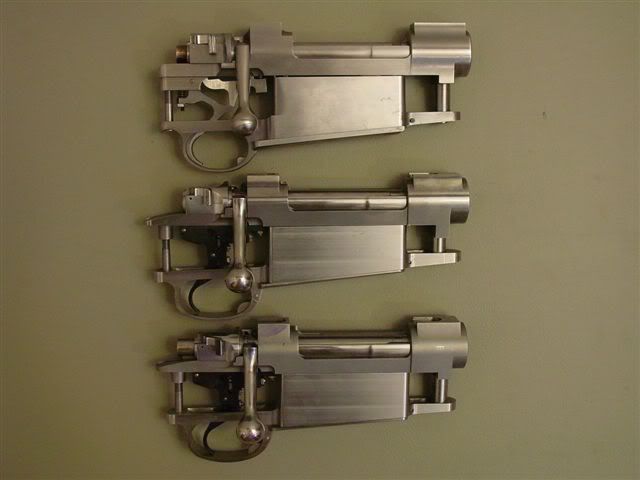 Bolt sleeves shown only for cosmetics 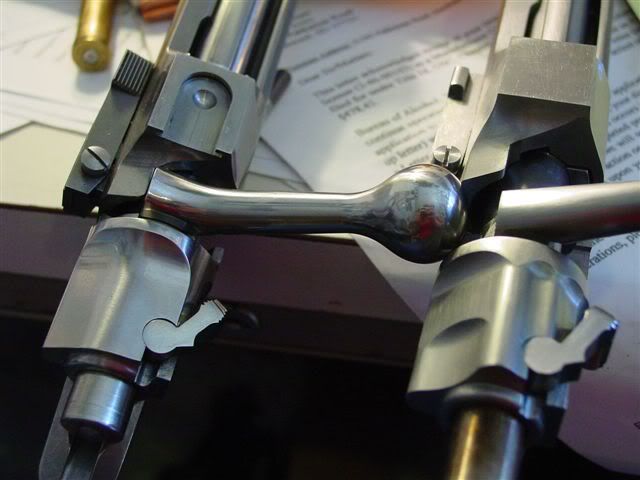 The floorplate thickness on the Satterlee is .337 vs. 253 for the GMA. Maybe the extra thickness could be used to mill a "well" for the follower? 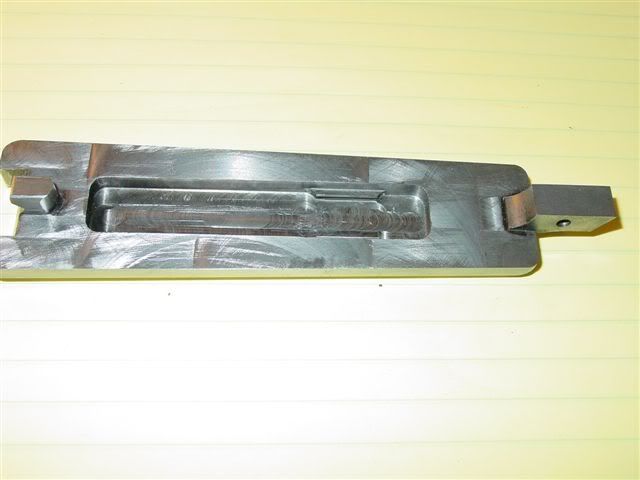 Visual difference in thickness 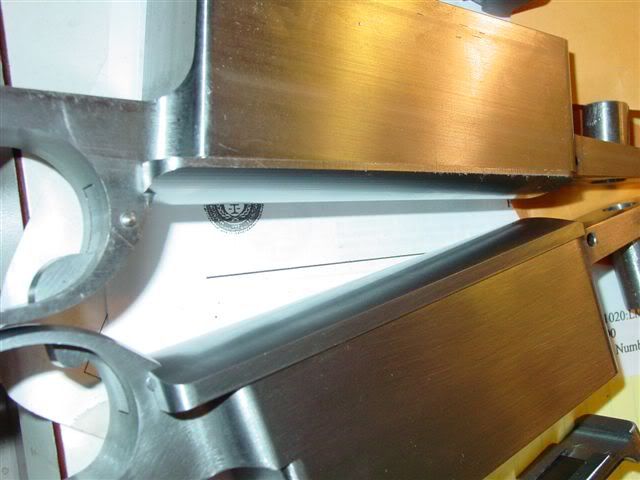 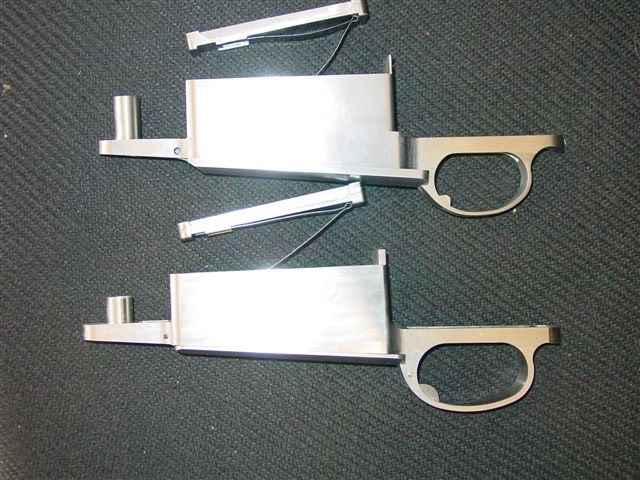 Near as I can determine, this should be the proper box width at the cartridge base. 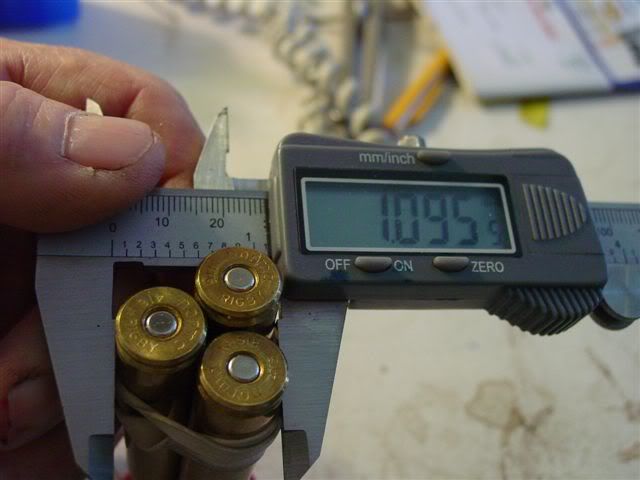 First of all, these are both darn fine actions and my hat's off to both mfg's for keeping the Mauser alive. Both actions follow Mauser principles without shortcut. Does that mean they are perfect? Well, depends on your definition. Both actions are pretty heavy. Satterlee came in at 3 lbs 13 oz, Shorter GMA at 3-11 and longer at 3-13. Satterlee is set up for the 416 Rigby, the GMA for the 404 Jeff and the larger GMA for the 500 Jeff. Big actions for big guns! Satterlee has done some hand work, GMA none that I can tell. The Satterlee appears to feed well, neither GMA will feed at all. The extractors on each extend beyond the "C" ring, so be sure to make a small extractor slot in the barrel. This is actually a good thing! A little more metal makes it easier for single loading (i.e drop one in the chamber and close the bolt over it) There appears to be room in the Satterlee action to allow the extractor to "climb" over the rim for single loading. Can't be positive, but as of now I don't think such room exists on the GMA without modification either to the extractor or action wall Needless to say, the gunsmith must make darn sure of this feature, especially on a dangerous game rifle. Jim Carmichael told me of a hairy experience barrel maker Buhmiller had on an elephant hunt using a Brevex action. Apparently Buhmiller stuffed one up the spout, slammed the bolt forward and now he has a thoroughly jammed gun. It will take a cleaning rod to knock out the stuck round...he survived to tell the story but had unkind words about the Brevex design. OK...let's move on! Cosmetically, the bolt handles on all these actions seem alarmingly long. I usually shorten these. The Satterlee bolt knob seems a bit small, but then again, this is only my opinion and can be changed out. The magazine depth on the Satterlee is a whopping 1.798 deep in front of the guard vs, 1.659 for both GMA's. For comparison sake only, a standard pot belly Mauser is about 1.516. Something can be done about the deep Satterlee. See my photo of what I call the "120 degree stack". In this case, (416 Rigby) it appears that the box inside width should be about 1.095. The Satterlee box is 1.015â€. Now let's look at the GMA. On the 404 action, the box is 1.013...spot on using the "120 degree stack" rule. But...GMA blew it on the 500..go figure! Rough calculations show that depth of the Satterlee box could be over .200 less had the 120 degree rule been used. As an observation, the GMA 500 would probably hold 4 down instead of 3 IF the 120 rule had been used there also. The one thing that did irk me a bit is that Satterlee used 1/4 x 28 guard screws instead of the conventional 1/4 x 22...that wouldn't be so bad, but he also made the head smaller. The Remington uses 1/4 x 28, but a different head configuration. So...if you damage a screw, be prepared to order one out from Satterlee or make your own. The GMA wisely uses the standard Mauser configuration. I should mention the triggers. GMA makes their own, a sort of standard configuration housing trigger. Satterlee went through a lot of trouble! His is kind of on the order of the M-70. Not quite as easily adjusted. In theory the Satterlee will be less sensitive to dust, grime build up. This action's trigger lets off at a crisp 3.5 lbs. About it! | ||
|
| One of Us |
I'm on record as being one of Stuart's supporters, but two things are obvious: The recoil lug is shorter. And the other action has a nicer treatment of the bolt stop/ejector box. flaco | |||
|
| One of Us |
I kind of like that design detail in the Saterlee where the trigger is made to follow the form of the triggerguard. | |||
|
| One of Us |
I agree that Stuart's trigger blade looks better, Kevin- And I'm impressed that Stuart manufactures his own triggers. But after two years in a target rifle shop, I believe in triggers, form follows function. Which may not be all the important in hunting rifles. What I'd like to know is if there is a convention for the geometry of the placement of the trigger blade in the trigger guard? Is there a standard--long proven--best way of approaching this? Also, Stuart's trigger is going to necessitate the removal of a lot of wood from the web. I guess we're all hoping to hear from others more expert than Kevin and I. flaco | |||
|
| One of Us |
I bet if a guy wanted a larger front recoil lug Saterlee would accomodate him. With regard to wood removal due to the trigger, when you get actions using that big of a cartridge you are more than likely going to use cross bolts to strenghen the stock. | |||
|
| One of Us |
Duane, Im gathering above image is the inside of the Satterlee plate? If indeed it is,I was under the strong impression Satterlee actions were finished to the highest degree. Which to me means among other things, that they should have a smooth drawn polished finish,(no machining marks) and be totally ready to blue. If I received custom bottom metal looking like that, Id not be thrilled. That is, unless one specified it like that,(for a lower price) and was prepared to do the finishing themselves. If you dont mind my asking, how does the Satterlee action fair up in regards to finish overall, both inside and out? | |||
|
| One of Us |
Those are some very fine looking actions, wish I could afford one. | |||
|
| One of Us |
I'd think if you wanted the Nth degreeof polishing, inside and out, the price would go up about $1200.00. These machine marks are totally acceptable...you'll find them on the flip side of any floorplate I've come across. As I mentioned, Stuarts's actions show hand work, certainly on the rails which explains why it appears to feed. The GMA will not allow catridges to climb out of the box...this one will require work. The normal detailing on either action will bring it "up to snuff" | |||
|
| One of Us |
Duane, Since both actions cost relatively the same amount (I think?) which one requires less work on your part to get it up to your standards? _________________________________ AR, where the hopeless, hysterical hypochondriacs of history become the nattering nabobs of negativisim. | |||
|
| One of Us |
Let's hold Duanes feet to the fire! Wink...I'd have to honestly say the Satterlee will take a little less work | |||
|
| One of Us |
Having received a few PM's,,a couple points: The Satterlee action has a .252 deep recoil lug. The smaller GMA is .238, the larger is .406 The measurement from the top of the tang to the woodline measured at about 1/2" behind the bolt handle is: Satterlee 1.977 GMA ditto +- On a 98 set up for the long mag, CNC bottom metal 1.795 Gonna make a pretty big grip! Why this is so, I can't figure | |||
|
| one of us |
Duane,how do these actions compare to a mod 70 in terms of feeding,for a 416 Rigby, or 458 Lott cartridge? | |||
|
| One of Us |
In regards to the depth of the recoil lug, i also notice that Stuarts has a fair amount more wood behind the recoil lug. That seems like a good idea. I love my Avatar Too Fellas. | |||
|
| One of Us |
Shootaway: Not sure exactly what you mean, but the feeding principles are similar..everything has to work in harmony whether a M-70 or Mauser...so many factors: Magazine box width, follower configuration, rail configuration, follower spring tension, extractor configuration and tension...and that's just to get it to feed...now we have to move on to extraction and ejection...like I say, everything has to be "tuned" | |||
|
| One of Us |
how do you contact satterlee? | |||
|
| one of us |
He has a website w/ phone # & email www.satterleearms.com | |||
|
| One of Us |
Ok, I'll factor $3000,+ approx.$1200 for a truelly finely finished Satterlee receiver. your professional assessment is very helpful and much appreciated. Thankyou. | |||
|
| one of us |
What is not seen on the satterlee action is that it is machined from prehardened billets so it is straight, THERE IS NO WARPAGE, just the way it should be, the GMA action is heat treated after machining, that i dont like Daniel | |||
|
| one of us |
I am confused. I thought the best way was to machine soft steel then harden? Doesn't it stand to reason that the harder steel will machine harder with more heat generated and be more prone to warpage? Howard Moses Lake, Washington USA hwhomes@outlook.com | |||
|
| one of us |
NO !!! the heat generated by machining a pre hardened billet of steel does no even register, when a action is machined soft and then hardened it warps! the reason why nearly all actions are machined soft its easier on the machinary and the tools, and thus cheaper, the only two peope that i know who machine there actions from prehardened billets are BRIAN HARRIE and SATTERLEE DANIEL | |||
|
| One of Us |
Having seen Saterlees" operation, I recall that some of machines he uses run cutting/cooling fluid during the machining process. And I also recall Stuart showing me the incredible number of milling cutters he needed to keep on hand to machine this pre-hardened steel. He had enough milling bits there to open a small store! | |||
|
| One of Us |
By all means, you should use the action you are most comfortable with | |||
|
| One of Us |
Then I'm I to think that all Pre-64 .375 Lenght Actions should be Worth their weight in Gold.. Nobody | |||
|
one of us |
That's a bit of blanket statement that isn't necessarily true, but the facts are, preheat treated 4140 is softer than free machining 4140 that has been later heat treated.......31RC as opposed to about 40-42. Ed Brown is also using the pre heat treat method....... Williams Machine Works  | |||
|
| One of Us |
Dakota also machines their actions from hardened steel, or at least they did before Kokesh. I don't know what they do these days. TT | |||
|
| One of Us |
A bit of a hijack, but any new books coming out soon? | |||
|
| One of Us |
IIRcorrectly, HARRE model 49 receivers are made from preheaTreat steel around the 35-37? rockwell range,bottom metal somewhere around 30 rockwell. I have the paperwork ,just need to find it and confirm. I believe Dakota76 actions have registered as low as 31-32 rockwell. | |||
|
| one of us |
Let me make sure I understand this. You spend 3,000 for a custom built action made for the caliber of your choice and it won't feed at all? I don't understand. I have spent several days considering this but my first reaction is still the same. That is a crock of you know what! Howard Moses Lake, Washington USA hwhomes@outlook.com | |||
|
| one of us |
And more points.
Again I have been considering shelling out a considerable amount of cash for a custom mauser action and these supposedly true to the full mauser design have magazine box dimensions that are not accurate. How can they be true mausers when one of the main principles of the mauser was magazine box and feed rail dimensions set for a specific cartridge? Howard Moses Lake, Washington USA hwhomes@outlook.com | |||
|
| one of us |
Duane, I think I know what you mean by the 120 degree rule but could you explain it please? Howard Moses Lake, Washington USA hwhomes@outlook.com | |||
|
| One of Us |
Ahhh...well..This is plane geometry. If you stack three rounds...say wrap a rubber band around them, they will form an equilateral triangle. this is the most effecient configuration for use of width and height. If the magazine is too narrow. you will form an isoscles triangle...too much height..the sides are equal, but the base is narrow. Of course, the sum of the angles, whether obtuse, scalene, right. isosceles or equilateral will all add up to 360 degrees...just a matter of effeciency | |||
|
| One of Us |
Duane, I may have forgotten alot of Geometry, but I seem to recall the sum of all angles of a triangle are 180 degrees. Help me if I am remembering incorrectly! Jim | |||
|
| one of us |
Yep 180 in a triangle and 360 in a square. As usual just my $.02 Paul K | |||
|
| one of us |
should the box not also be tapered front to back? Assuming of course a typical cartridge that narrows as you move from base to neck. Howard Moses Lake, Washington USA hwhomes@outlook.com | |||
|
one of us |
I believe this was a quote from Tom Burgess on the subject a few years ago......... Pretty good info.
Williams Machine Works  | |||
|
| one of us |
so the question is why are the measurements not right? That seems to be a foundation flaw. Howard Moses Lake, Washington USA hwhomes@outlook.com | |||
|
| one of us |
HOWARD you can give the dimensions of the box you want to Stuart and he will oblige, thats no big deal...or issue, you match the box to the specific cartridge. GMA actions more often than not dont feed when they leave the shop, i have spoken to a number of friends that have bought GMA actions and that has been there experience also, plus they are pretty rough, need a lot of polishing etc etc, the action that i got from stuart feeds like snot, and is smooth like rubbing two bits of wet glass together, is the best way i can describe Daniel | |||
|
| one of us |
GMA seems to have a good rep. I wonder why its acceptable to supply actions that are so in need of final finish that they won't even feed? Makes me wonder if I am missing something. Howard Moses Lake, Washington USA hwhomes@outlook.com | |||
|
| one of us |
I am gun shy right now about delivery times etc with these actions. If I could get that successfully resolved I would immediately order a pair of Satterlee actions. Howard Moses Lake, Washington USA hwhomes@outlook.com | |||
|
| one of us |
HOWARD i know what you mean , need i say more !! Daniel | |||
|
| Powered by Social Strata | Page 1 2 |
| Please Wait. Your request is being processed... |
|

Visit our on-line store for AR Memorabilia

